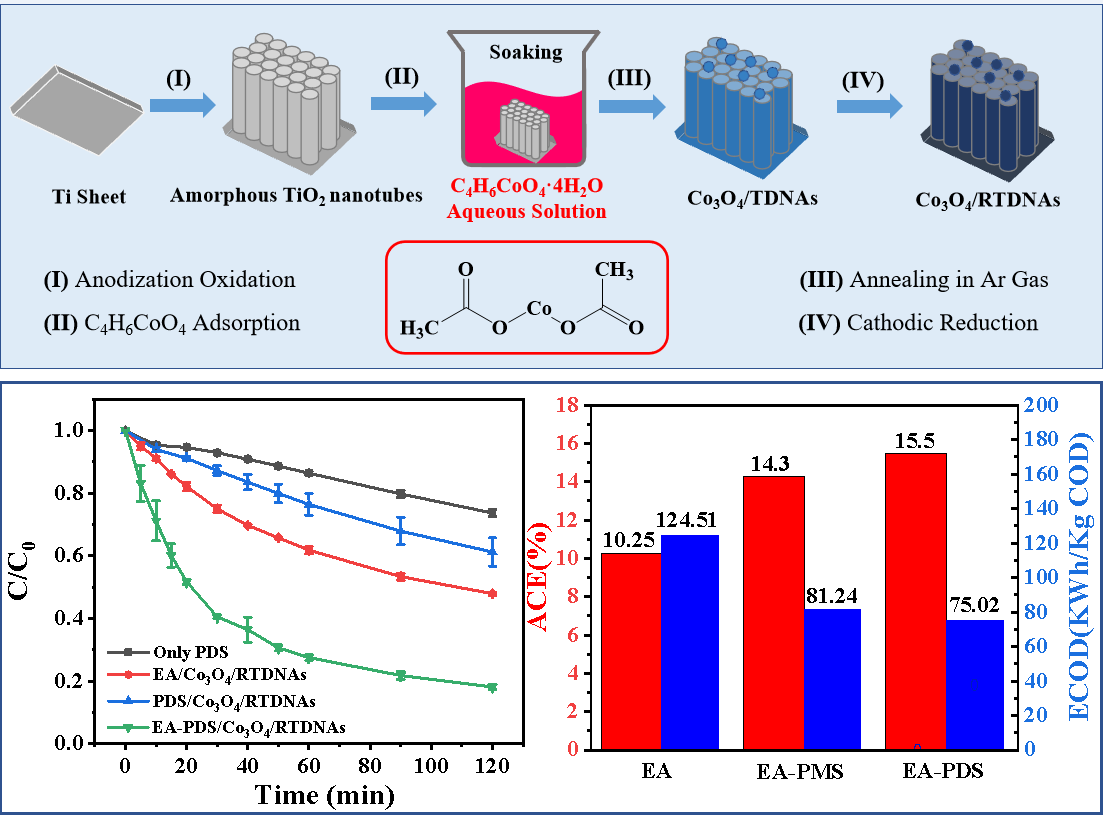博文
祝贺邱帆,王璐瑶等同学合作论文在Journal of Colloid and Interface Science发表
||
Electrochemically enhanced activation of Co3O4/TiO2 nanotube array anode for persulfate toward high catalytic activity, low energy consumption, and long lifespan performance
Fan Qiu a, Luyao Wang a, Hongxiang Li b, Yanan Pan a, Haiou Song b, *, Junjie Chen a, Yang Fan a, Shupeng Zhang a, *
Abstract
Advanced oxidation processes (AOPs) can directly degrade and mineralize organic pollutants (OPs) in water by generating reactive oxygen species with strong oxidizing ability. The development of advanced electrode materials with high catalytic performance, low energy consumption, no secondary pollution, and long lifespan has become a challenge that must be addressed in this field. A heterojunction catalyst loaded with Co3O4 on TDNAs (Co3O4/RTDNAs) was designed and constructed by a simple and efficient pyrolysis (Co3O4/TDNAs) and electrochemical reduction. Co3O4 can be uniformly distributed on the inner wall and surface of the TiO2 nanotubes, enhancing the specific surface area while forming a tight conductive interface with TiO2. This facilitates rapid transmission of electrons, thereby assisting Co3O4 in quickly activating PS to form reactive oxygen species. The Ti3+ and Ov generated in Co3O4/RTDNAs can significantly improve the electrocatalytic degradation of OPs. Also, the interface formed by Co3O4 and RTDNAs will effectively suppress Co2+ leakage, thereby reducing the risk of secondary pollution. When the reaction conditions were 1 mM PMS (PDS) and a current density of 5 mA/cm2 in the EA-PMS (PDS)/Co3O4/RTDNA system, 30 mg/L TC can achieve 83.24% (81.89%) removal in 120 min, with very low cobalt ion leaching, while the energy consumption was reduced significantly. Therefore, EA-PS/Co3O4/RTDNA system has strong stability and a high potential for treating the OPs in AOPs.
In summary, we prepared a novel Co3O4/RTDNA anode by electrochemical oxidation, room temperature impregnation, high-temperature annealing, and cathodic reduction. The anode was then applied to electrochemically activated persulfate (EA-PS) to degrade tetracycline (TC). The Co3O4/RTDNA anode has a unique structure rich in oxygen defects and Ti3+. CV, LSV, and EIS results show that Co3O4 loading enhances TiO2 conductivity, while cathodic reduction can further increase the OEP of the electrode (2.34 V vs. SCE). The charge transfer resistance of the electrode was reduced, and the cathode reduction significantly improved the stability of the Co3O4/RTDNA electrode, having a service life of 600 h.

When the reaction conditions were 1 mM PMS (PDS) and a current density of 5 mA/cm2 in the EA-PMS (PDS)/Co3O4/RTDNA system, 30 mg/L TC can achieve 83.24% (81.89%) removal in 120 min, with very low cobalt ion leaching. The TC removal conformed to a pseudo-second-order kinetic model, suggesting that the Co3O4/RTDNA anode has excellent catalytic performance for EA-PS. In the EA-PS/Co3O4/RTDNA system, TC was degraded through the free radical pathway, and ·OH and SO4-· were essential to the process. Due to the different structure and oxidation pathway of persulfate, the proportions of free radicals in EA-PMS/Co3O4/RTDNA reaction system and EA- PDS/Co3O4/RTDNA reaction system are different. The TC degradation pathways include elimination reaction, hydroxyl addition, amino oxidation, demethylation, dehydration, etc. ECOSAR identified that the acute toxicity of most intermediates reduced during the degradation. Compared with the EA/Co3O4/RTDNA system, the COD removal and current efficiency of the EA-PMS(PDS)/Co3O4/RTDNA system were significantly improved, while the energy consumption was reduced significantly. Therefore, Co3O4/RTDNAs can be used and reused as a new anode for EA-PS OPs degradation; it has strong stability and a high potential for treating the organic matter in wastewater.
https://blog.sciencenet.cn/blog-311896-1409330.html
上一篇:祝贺潘雅楠等同学合作论文在Materials Today Chemistry期刊发表
下一篇:范扬老师参加2023年中国化学会第十二届全国环境化学大会